ENDLESS SUMMER
ENDLESS SUMMER
From the spicy food to its sizzling streets and violent history, David Dawson finds the heat has always been on in Chongqing
品味山城:路在腳下蜿蜒,辣在舌尖舞蹈

Hongya Cave is a popular tourist and shopping destination
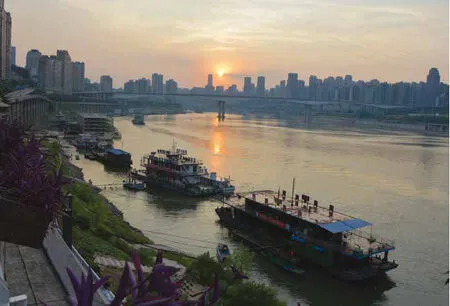
Bars across the road from Hongya Cave ofer views of the river at sunset
You can see the effects of the heat before you feel it.
Stepping off the subway at Xiaoshizi, right in the heart of the Yuzhong peninsula (渝中半島) that forms the core of Chongqing city, elderly people and children prop themselves up against the walls and stairs of both exits, fanning themselves and biding their time.
On reaching the top of the stairs, you find out why. Chongqing is considered one of the four “furnaces”of China, along with Wuhan, Nanjing, and, depending who you ask, Changsha or Nanchang. The heat is oppressive; if you’re visiting during summer, you’re going to end up planning whole days around the temperature.
Chongqing is not an easy city to navigate. Aside from the fact two rivers join at the heart of the city, walking anywhere requires covering almost as much vertical distance as horizontal. Traffic, for the most part, is surprisingly uncongested but on the flip side, roads are long and winding. What might be an 800-meter trip, as the crow flies, can very easily become a five-kilometer journey around serpentine trails, even right near the center of town. (If possible, register on a transport app like Didi Chuxing before you go, to avoid roasting in the sun while struggling to get a cab).
Going by foot may seem a better way to take in the sights, but be warned—while there are hidden pathways on the steep inclines, the city is in a constant frenzy of construction; what looks like a pathway on maps is often obstructed by a building site. You are probably going to have to backtrack more than once.
Yuzhong is easily the most convenient location to stay, as the name ought to make clear. The first character is derived from another name for Chongqing, 渝 (yú), which references the ancient Bayu (巴渝) culture. When you take “渝” and“中” you literally get “Chongqing’s middle.”
When booking, it’s worth scoping out the options to find a room on a high floor: Given Chongqing’s vertical nature, the views can be spectacular. Tall buildings emerge from lush foliage, looking almost like they are stacked upon one another. If you hold an overseas passport, be careful though—not every hotel has the necessary paperwork to host foreigners. Ask upfront when booking.
TALL BUILDINGS EMERGE FROM LUSH FOLIAGE, LOOkING ALMOST LIkE THEY ARE STAckED UPON ONE ANOTHER
Once you’re settled in, the next question is: where to? The first task is probably to find some of the city’s cuisine to try. Chongqing is home to both the famous local variety of hotpot and laziji (辣子雞, chicken deep-fried in numbing spice). If you have a reasonable tolerance for chili, it’s almost a crime to not indulge in both while visiting. Most of your choices are going to be spicy, though.
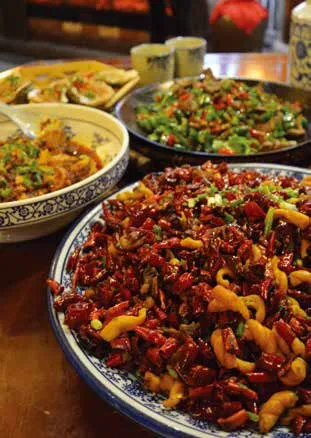
Yangji Longfu's laziji is recommended only for those who can handle serious spice
Given Chongqing’s infamy in this area, you could be forgiven for assuming that the history of spicy food goes back thousands of years, but it wasn’t until the 16th century that chili peppers came to China from South America via Portuguese traders and became a hit with locals.
There are various reasons why. Traditional Chinese Medicine has long influenced the cooking culture, including the belief that humidity—and its ill effects, such as rheumatism—can be counteracted by spicy food. Some locals will tell you that the sweat generated by chili helps flush out toxins, and that the spice helps with digestion (though many diners would claim the opposite).
Those less enamored with the traditional Chinese medicine explanation point to the prevalence of spicy food in humid climates around the world, and argue that the spicy ingredients served to protect the food against bacteria, while also masking the negative taste associated with spoilage.
In any case, that history doesn’t help you find the best food. Crowdsourced sites such as Dianping.com, however, can.
Many recommend the centrally located Yangji Longfu (楊記隆府), in the Jiefangbei district of Yuzhong, for some of the city’s best fried chicken. Yangji Longfu’s chicken is similar to the laziji on menus all over the country, but with subtle differences. The fried chunks are crumblier, and a little less crisp; the flavor is stronger, with undertones of ginger. Be prepared to nibble around bones and excavate for remainders among piles of chili and fried dough twists (mahua). Compared with some versions of this dish, the liptingling ma flavour is subdued, while the searing la spiciness is far stronger: Have watermelon handy to take the edge off, and if your stomach is at risk of any adverse reaction, eat plenty of rice.
The other key spicy dish to try is, of course, Chongqing’s infamous hotpot—less a dish than a method of cooking, with each table equipped with a pot of spicy soup that they boil assorted items in. A hotpot menu includes everything from quail eggs, fish, and organs through to vegetables, beef, and an array of sauces to dip the foods in.
Hotpot restaurants abound in this city. Locals go for one big pot of spicy soup, potentially divided into nine sections jiugongge (九宮格) so different things can be cooked at different speeds, but it’s not necessary to order this unless you’re a hotpot expert. Tourists can stick with the yuanyang (鴛鴦) option, a pot which comes split into two sections, with spicy and nonspicy soup (the non-spicy soup is often flavored with mushroom, or maybe a light salty stock with dates).
As for what to cook in it, that’s up to the customer–but if you want to stick with heat all the way, the spice-rubbed beef is a tasty option. As it happens, one of the city’s most popular hotpot restaurants, Zhiyanhe Hotpot (紙鹽河碼頭火鍋) is also located at one of the Yuzhong’s most picturesque tourist attractions, Hongya Cave (洪崖洞). Make sure you book ahead, because the restaurant is in high demand.
Hongya Cave itself is well worth a visit. Despite the name, this destination isn’t really a cave—it’s a commercial area. Part street, part tower, part staircase, Hongya Cave is taller than it is wide. From the bottom, Hongya Cave resembles a series of woodenstructures trying to cling to the side of a cliff. These diaojiaolou (吊腳樓), “stilt buildings,” are a traditional architectural style of the Bayu culture, thus were considered the perfect item to recreate during a 1990s project to gentrify the area for tourism. Previously, it had been home to dense fishing communities packed around the eponymous cave, though it isn’t an entirely recent attraction—atlases published back in 1453 designated“Eight Scenic Spots of Yu City,”one of which was called “Verdant Drops from Hongya” in reference to a waterfall in the area. There’s still a scenic look-out near that waterfall, though now the view is mostly of a giant bridge stretching over to skyscrapers on the other side of the river.
EVEN IF YOU cHOOSE TO STAY AWAY FROM HOTPOT ON THIS TRIP, IT’S IMPOSSIBLE TO EScAPE SPIcES ENTIRELY-ENTIRE SHOPS ARE DEDIcATED TO LOcAL cOOkING INGREDIENTS
The “street” itself will almost certainly be crowded, but is worth browsing for some local snack samples or an overpriced drink at one of the bars or coffee shops. Even if you choose to stay away from hotpot on this trip, it’s impossible to escape spices entirely—entire shops are dedicated to local cooking ingredients, and their prize products are solid blocks of hotpot soup stock, the chilis clearly visible. At the top of Hongya Cave is an exit, so don’t worry about trying to navigate back down through the madding crowds. There are also some nice views of the river at the top. For the best views, however, you will want to take a trip on the famous Yangtze River Cable Car.
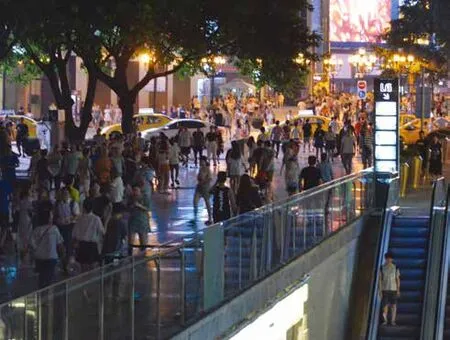
The central area of Yuzhong is packed with shopping malls
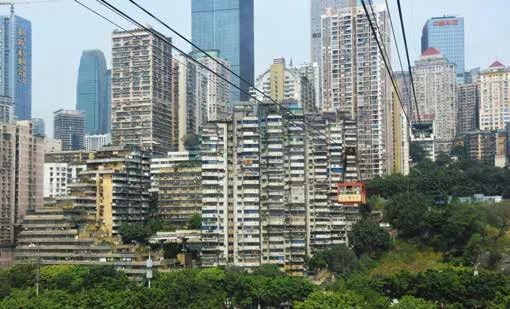
In operation since 1987, the Chongqing cable car is worth the ticket price, if not the crowds
This cable car runs from the central Xiaoshizi area, not too far from Hongya Cave, across to the lesstrafficked district of Nanbinlu on the other side of the river. It’s probably wiser to start from the Nanbinlu side to avoid longer queues, so if you are worried about the long wait, your best bet is probably to get a taxi to take you there, then come back to the center of the city via the cable car. Otherwise, you can opt for a round trip from Xiaoshizi and back.
Either direction you take, the car itself will be stuffed with tourists, so fortitude is needed to push your way to the front or rear and enjoy the views. Like most local attractions, it’s cheap,at 20 RMB for a one-way trip and 30 RMB return—though you may find yourself wishing it was a bit more expensive to cut down on the crowds. Its operating hours are 7:30 a.m. to 10:30 p.m. and you can book tickets online up to five hours ahead of your departure time.
Take some time after getting off to snap a few pictures from the edge of the station, while taking note of what’s left of the original cable car, now a small museum attraction. The mechanical equipment dates from 1987 and was used primarily for commuting rather than ferrying tourists, but has undergone renovations and featured in a number of films during its three decades of service. If you want to stir up some memories of Chongqing after your trip, but want something different than reviewing your holiday snaps, try watching Crazy Stone, a crime caper similar in tone and plot to Guy Ritchie’s Snatch, and enjoy the sequences set on the cable car.
But if you really want a big helping of China’s modern history and culture, then you’re going to have to go further afield than Chongqing’s center, out to Gele Mountain. That’s going to require a long car ride.
On the mountain, about 16 kilometers from the city center, are two connected prison sites that chronicle the tragedies of an early generation of Communist idealists. These tales, which form the basis of the famous novel Red Rock (《紅巖》), are related through a handful of English-language captions that offer the state-sanctioned version of events that took place at Baigong, a warlord’s villa repurposed as an interrogation site by the ruling Kuomintang during China’s civil war, and the nearby Zhazidong, where Communist Party members were once kept as prisoners.
There is some juxtaposition between the pleasant if steep forest walk that precedes a visit to Gele Mountain, and the macabre history on display when one arrives. Many of these sites are where “revolutionary martyrs”were tortured or executed. One of the more famous is Song Zhenzhong, known as “Little Radish” because of his small stature and big head. Little Radish was 9 when he and his parents were imprisoned and executed for publishing a political tract. His tragic tale is often taught to schoolchildren in China.
THERE IS SOME JUXTAPOSITION BETWEEN THE PLEASANT IF STEEP FOREST WALk THAT PREcEDES A VISIT TO GELE MOUNTAIN, AND THE MAcABRE HISTORY ON DISPLAY WHEN ONE ARRIVES
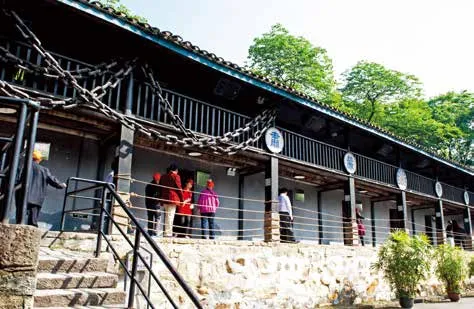
Communist revolutionaries were once imprisoned at Zhazidong
A cluster of drivers await unwary visitors to the main entrance of Baigong Villa, offering vehicular tours of the prison for 80 RMB and up—fine if you don’t feel like walking, but the entrance is free and you should at least see Baigong Villa before taking up the offer (and there are much cheaper rides to the prison available from the other side of the villa).
Wandering the prison site, it’s easy to relax and muse upon the tortured history of this place, and the jarring contrast with the many young visitors laughing and playing.
A more pleasant musing, perhaps, is the fact that Gele Mountain is not only known for its violent political intrigue, but is also reputed to be the place where Chongqing’s aforementioned famous spicy chicken dish, laziji, originated.
It would seem that even here, miles from the center of Chongqing, beneath the leafy canopy and surrounded by tales of death and murder, you still can’t escape the heat, nor the spice that infuses every aspect of the region.
——本刊2020年重磅推出《鹽河舊事》(專欄)

